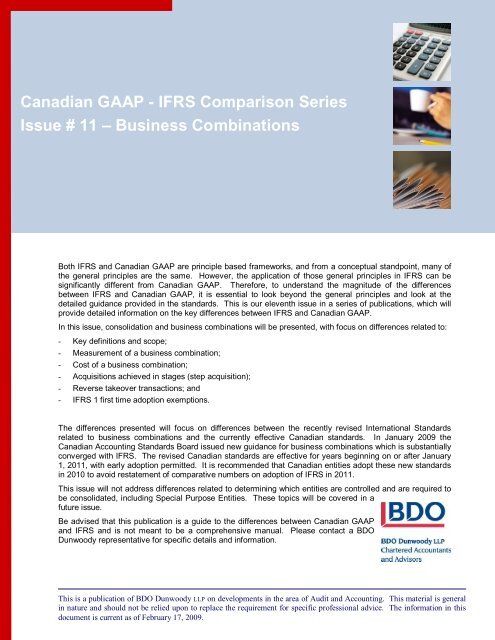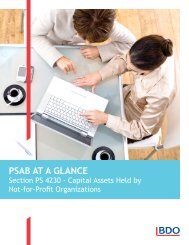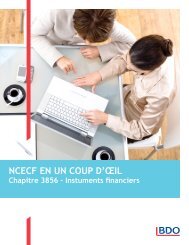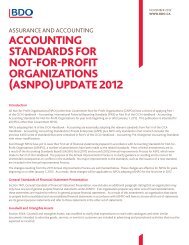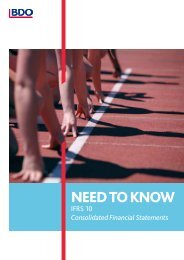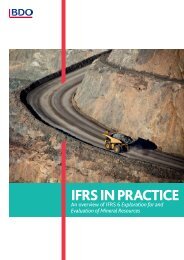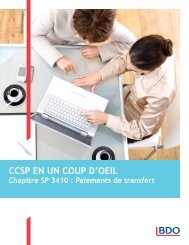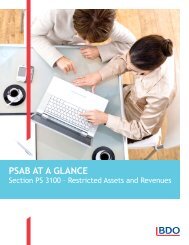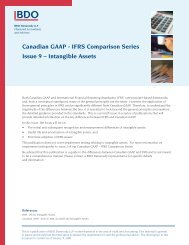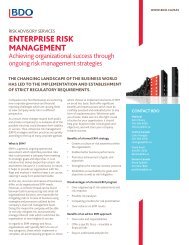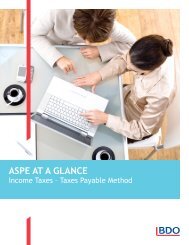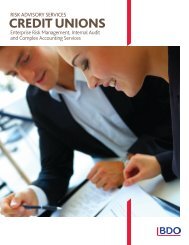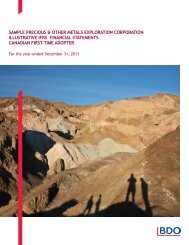Business Combinations - IFRS Canadian GAAP Differences Series
Business Combinations - IFRS Canadian GAAP Differences Series
Business Combinations - IFRS Canadian GAAP Differences Series
Create successful ePaper yourself
Turn your PDF publications into a flip-book with our unique Google optimized e-Paper software.
<strong>Canadian</strong> <strong>GAAP</strong> - <strong>IFRS</strong> Comparison <strong>Series</strong>Issue # 11 – <strong>Business</strong> <strong>Combinations</strong>Both <strong>IFRS</strong> and <strong>Canadian</strong> <strong>GAAP</strong> are principle based frameworks, and from a conceptual standpoint, many ofthe general principles are the same. However, the application of those general principles in <strong>IFRS</strong> can besignificantly different from <strong>Canadian</strong> <strong>GAAP</strong>. Therefore, to understand the magnitude of the differencesbetween <strong>IFRS</strong> and <strong>Canadian</strong> <strong>GAAP</strong>, it is essential to look beyond the general principles and look at thedetailed guidance provided in the standards. This is our eleventh issue in a series of publications, which willprovide detailed information on the key differences between <strong>IFRS</strong> and <strong>Canadian</strong> <strong>GAAP</strong>.In this issue, consolidation and business combinations will be presented, with focus on differences related to:- Key definitions and scope;- Measurement of a business combination;- Cost of a business combination;- Acquisitions achieved in stages (step acquisition);- Reverse takeover transactions; and- <strong>IFRS</strong> 1 first time adoption exemptions.The differences presented will focus on differences between the recently revised International Standardsrelated to business combinations and the currently effective <strong>Canadian</strong> standards. In January 2009 the<strong>Canadian</strong> Accounting Standards Board issued new guidance for business combinations which is substantiallyconverged with <strong>IFRS</strong>. The revised <strong>Canadian</strong> standards are effective for years beginning on or after January1, 2011, with early adoption permitted. It is recommended that <strong>Canadian</strong> entities adopt these new standardsin 2010 to avoid restatement of comparative numbers on adoption of <strong>IFRS</strong> in 2011.This issue will not address differences related to determining which entities are controlled and are required tobe consolidated, including Special Purpose Entities. These topics will be covered in afuture issue.Be advised that this publication is a guide to the differences between <strong>Canadian</strong> <strong>GAAP</strong>and <strong>IFRS</strong> and is not meant to be a comprehensive manual. Please contact a BDODunwoody representative for specific details and information.This is a publication of BDO Dunwoody LLP on developments in the area of Audit and Accounting. This material is generalin nature and should not be relied upon to replace the requirement for specific professional advice. The information in thisdocument is current as of February 17, 2009.
References<strong>IFRS</strong>: <strong>IFRS</strong> 3 (Revised 2008), <strong>Business</strong> <strong>Combinations</strong>, IAS 27 (Revised 2008), Consolidated andSeparate Financial Statements.<strong>Canadian</strong> <strong>GAAP</strong>: Section 1581, <strong>Business</strong> <strong>Combinations</strong>, Section 1590, Subsidiaries, Section 1600,Consolidated Financial Statements, Section 3840, Related Party Transactions, EIC 10 – ReverseTakeover Accounting, EIC 14 - Adjustments To The Purchase Equation Subsequent To The AcquisitionDate, EIC 94 – Accounting for Corporation Transaction Costs, EIC 114 - Liability Recognition For CostsIncurred On Purchase <strong>Business</strong> <strong>Combinations</strong>, EIC 119 - The Date Of Acquisition In A <strong>Business</strong>Combination, EIC 124 – Definition Of A <strong>Business</strong>, EIC 125 - Determination Of The Measurement DateFor The Market Price Of Acquirer Securities Issued In A <strong>Business</strong> Combination, EIC 140 - Accounting ForOperating Leases Acquired In Either An Asset Acquisition Or A <strong>Business</strong> Combination, EIC 154 -Accounting For Pre-Existing Relationships Between The Parties Of A <strong>Business</strong> Combination.Key Definitions and ScopeBoth <strong>Canadian</strong> <strong>GAAP</strong> and <strong>IFRS</strong> define a business combination as a transaction or other event in whichan acquirer obtains control over one or more businesses. Both sets of standards also define the date ofacquisition as the date which control is transferred.It is important to understand the differences in the key definitions related to business combinations under<strong>Canadian</strong> <strong>GAAP</strong> and <strong>IFRS</strong>. Some of the slight differences in definitions may give rise to vast differencesin accounting treatment.<strong>Canadian</strong> <strong>GAAP</strong>A business is a self-sustaining integrated set ofactivities and assets conducted and managed forthe purpose of providing a return to investors. Abusiness consists of:(a) Inputs;(b) Processes applied to those inputs; and(c) Resulting outputs that are used to generaterevenues.For a transferred set of activities and assets to bea business, it must contain all of the inputs andprocesses necessary for it to continue to conductnormal operations after the transferred set isseparated from the transferor, which includes theability to sustain a revenue stream by providing itsoutputs to customers.The transitional provisions of Section 1581essentially provides a scope limitation forbusiness combinations between two or more cooperativeenterprises. For these transactions, thepooling of interests method may be used.Under <strong>Canadian</strong> <strong>GAAP</strong>, control is not specificallysited as a determinant of the acquirer. Rather,specific factors are identified such as:– The entity that transfers the cash or other<strong>IFRS</strong>Under <strong>IFRS</strong>, a business is defined as anoperation that is capable of being conducted andmanaged for the purpose of providing a return toinvestors by way of dividends, lower costs, orother economic benefits.This means that a number of transactions thatwere previously dealt with as asset acquisitionswill be treated as business combinations under<strong>IFRS</strong>. For example, an entity in its developmentstage can meet the definition of a business.There is no scope limitation for co-operativeenterprises. The pooling of interests method ofaccounting is prohibited.Under <strong>IFRS</strong>, the acquirer is the entity that obtainscontrol of the acquiree. The definition of control isprovided in IAS 27. If a business combination hasoccurred but applying the guidance in IAS 27BDO Dunwoody LLP is a Member Firm of BDO International. BDO International is a world wide network ofpublic accounting firms, called BDO Member Firms, serving international clients. Each BDO Member Firm is anindependent legal entity in its own country.
assets or incurs the liabilities;– The entity that issues its equity interests;– The relative voting rights in the combinedentity after the business combination;– The existence of a large non-controllinginterest in the combined entity if no otherowner(s) holds the largest non-controllingvoting interest in the combined entity;– The composition of the governing body ofthe combined entity;– The composition of the seniormanagement of the combined entity;– The terms of exchange of equity interests;– The relative size of the entity aftercombination; and– The entity that initiated the combination.does not clearly indicate which of the combiningentities is the acquirer, the same factors which areidentified in <strong>Canadian</strong> <strong>GAAP</strong> are considered todetermine the acquirer.The acquisition date is the date on which theacquirer obtains control of the acquiree.The date of acquisition is either:(a) The date on which the net assets or equityinterests are received and the considerationis given; or(b) The date of a written agreement, or a laterdate designated therein, that provides thatcontrol of the acquired enterprise iseffectively transferred to the acquirer on thatdate, subject only to those conditionsrequired to protect the interests of the partiesinvolved.Under <strong>Canadian</strong> <strong>GAAP</strong>, common control / relatedparty transactions are accounted for inaccordance with Section 3840 – Related PartyTransactions. For transactions required to beaccounted for at carrying value, “continuity ofinterest” accounting is used. However if thetransaction meets the requirements to berecorded at exchange amount, the transaction isaccounted for a business combination inaccordance with Section 1581.The acquisition date is the date on which theacquirer obtains control of the acquiree.This is generally the date that the acquirer legallytransfers the consideration, acquires the assetsand assumes the liabilities of the acquiree. Itcould also be an earlier date if the acquirerobtains control earlier than the closing date. Thisis consistent with <strong>Canadian</strong> <strong>GAAP</strong>.Common control transactions are outside of thescope of <strong>IFRS</strong> 3 Revised. Entities can make anaccounting policy choice to account for suchtransactions. Once an accounting policy choice ismade, the treatment should continue to be appliedconsistently going forward.BDO Dunwoody LLP is a Member Firm of BDO International. BDO International is a world wide network ofpublic accounting firms, called BDO Member Firms, serving international clients. Each BDO Member Firm is anindependent legal entity in its own country.
Accounting Treatment of a <strong>Business</strong> CombinationThe accounting for a business combination is where the key differences arise between current <strong>Canadian</strong><strong>GAAP</strong> and the revised <strong>IFRS</strong> 3. The differences that will be discussed in the following analysis focus onthe measurement of a business combination, the consideration in a business combination and thetreatment of other acquisition costs. This section will conclude with a discussion on the impact on thenon-controlling interest (NCI) as a result of these other factors.Measurement of a <strong>Business</strong> Combination<strong>Canadian</strong> <strong>GAAP</strong>Under <strong>Canadian</strong> <strong>GAAP</strong>, when an acquirerpurchases less than 100% of an acquiree, theassets and liabilities are adjusted by a fairvalue increment only to the extent of theacquirer’s percentage ownership of theacquiree.Under <strong>Canadian</strong> <strong>GAAP</strong>, there are noexceptions to the measurement principle.Specific guidance is provided on assigningamounts to certain assets acquired andliabilities assumed. Measurement guidance isprovided on the following topics:Inventories; Plant and Equipment; Accrued benefit assets / liabilities fordefined benefit plans for employeefuture benefits; and Income Taxes.<strong>IFRS</strong>Under <strong>IFRS</strong>, when an acquirer purchases lessthan 100% of an acquiree, the full fair value ofidentifiable assets acquired and liabilitiesassumed is recognized.Under <strong>IFRS</strong> there limited exceptions to themeasurement principle for specific types ofidentifiable assets and liabilities. Theseexceptions include: Contingent liabilities; Indemnification Assets; Reacquired Rights; Income Taxes–follow IAS 12 IncomeTaxes; Employee Benefits – follow IAS 19Employee Benefits; Share Based Payments – follow <strong>IFRS</strong> 2Share Based Payments; andAssets Held for Sale – follow <strong>IFRS</strong> 5 NoncurrentAssets Held for Sale andDiscontinued Operations.A contingent liability assumed in a businesscombination shall be recognized at the acquisitiondate, if it is a present obligation that arises frompast events and its fair value can be measuredreliably. This is contrary to the guidance in IAS 37– Provisions, Contingent Liabilities, andContingent Assets, since the acquirer recognizesa contingent liability assumed in a businesscombination at the acquisition date even if it is notprobable that an outflow of resources embodyingeconomic benefits will be required to settle theobligation.An indemnification asset is recognized as anasset and measured using the samemeasurement basis as the related contingentBDO Dunwoody LLP is a Member Firm of BDO International. BDO International is a world wide network ofpublic accounting firms, called BDO Member Firms, serving international clients. Each BDO Member Firm is anindependent legal entity in its own country.
liability subject to the need for a valuationallowance for uncollectible amounts. For anindemnification asset measured at fair value, theeffects of uncertainty about future cash flowsbecause of collectability considerations areincluded in the fair value measure and a separatevaluation allowance is not necessary. There is nospecific guidance in <strong>Canadian</strong> <strong>GAAP</strong> onindemnification assets.For reacquired rights, the acquirer shall measurethe value of a reacquired right recognized as anintangible asset on the basis of the remainingcontractual term of the related contract. <strong>Canadian</strong><strong>GAAP</strong> provides limited guidance on reacquiredrights with the only guidance being specific thereacquisition of troubled franchises by thefranchisor.Under <strong>Canadian</strong> <strong>GAAP</strong>, the criteria to recognizeintangible assets apart from goodwill are thesame as <strong>IFRS</strong>.An intangible asset should be recognized apartfrom goodwill when:(a)(b)The asset results from contractual or otherlegal rights (regardless of whether thoserights are transferable or separable fromthe acquired enterprise or from other rightsand obligations); orThe asset is capable of being separated ordivided from the acquired enterprise andsold, transferred, licensed, rented, orexchanged (regardless of whether there isan intent to do so).Under <strong>IFRS</strong>, intangible assets are recognizedapart from goodwill when the intangible assetmeets either the separability criterion or thecontractual-legal criterion. An intangible assetthat meets the contractual-legal criterion even ifthe asset is not transferable or separable from theacquiree or from other rights and obligations. Thisis consistent with <strong>Canadian</strong> <strong>GAAP</strong>.If neither of these criterion are met, then theintangible asset should be included in theamount recognized as goodwill.Under <strong>Canadian</strong> <strong>GAAP</strong> goodwill is measured asthe difference between the cost of acquisition andthe acquirer’s interest in the net fair value of theassets acquired and liabilities assumed at thedate of acquisition.In the case of negative goodwill, the excess of thecost of acquisition is first deducted proportionatelyfrom the purchase price allocated to certain nonmonetaryassets until their carrying value hasbeen ‘grinded down’ to zero. Any remainingexcess is recognized as a gain in the incomestatement.Under <strong>IFRS</strong>, goodwill is measured as thedifference between:(a) The aggregate of:(b)- The acquisition-date fair value of theconsideration transferred;- The amount of any NCI;- In a business combination achieved instages, the acquisition-date fair valueof the acquirer's previously-heldequity interest in the acquiree; andThe net of the acquisition-date amounts ofthe identifiable assets acquired and theliabilities assumed.BDO Dunwoody LLP is a Member Firm of BDO International. BDO International is a world wide network ofpublic accounting firms, called BDO Member Firms, serving international clients. Each BDO Member Firm is anindependent legal entity in its own country.
If the difference between (a) and (b) is negative,this is termed a bargain purchase. When abargain purchase arises, an acquirer mustreassess whether it has correctly identified andmeasured all of the components of the businesscombination. If it truly is a bargain purchase thegoodwill is reduced to zero and any gainremaining is recognized in the income statement.Under <strong>Canadian</strong> <strong>GAAP</strong>, the timeframe foradjustments to the purchase equation subsequentto the acquisition date is consistent with the 12-month window provided in <strong>IFRS</strong>. However,<strong>Canadian</strong> <strong>GAAP</strong> does allow for a window beyond12 months in very unusual circumstances. Suchadjustments do not require retrospectiveapplication with restatement of comparativefigures, unless the adjustment is for the correctionof an error.Under <strong>Canadian</strong> <strong>GAAP</strong>, the non-controllinginterest is calculated as the portion of ownershipinterest of the carrying amount of net assets of theacquiree that are not acquired by the acquiree.Adjustments to the measurement of the businesscombination can be made within themeasurement period, which cannot exceed 12months from the date of acquisition. Adjustmentsare limited to better knowledge about facts andcircumstances that existed at the acquisition date.Such adjustments are made retrospectively andcomparative information is revised.Adjustments that are made based on conditionsthat exist after the acquisition date should beregarded as subsequent transactions that are notpart of the business combination and should betreated separately.Under <strong>IFRS</strong>, the non-controlling interest ismeasured using either:- The fair value of the non-controlling interest;or- The proportionate interest of the fair value ofnet identifiable assets of the entity acquired.Cost of Acquisition in a <strong>Business</strong> Combination<strong>Canadian</strong> <strong>GAAP</strong>Under <strong>Canadian</strong> <strong>GAAP</strong>, consideration in abusiness combination is the aggregate of the fairvalue of the assets obtained, liabilities assumed,and equity interests issued.The fair value of any equity securities issued bythe acquirer is determined by the market price fora reasonable period before and after the terms ofthe acquisition are agreed to and announced.In <strong>Canadian</strong> <strong>GAAP</strong>, there are very strict criteria forrecognizing contingent consideration at theacquisition date.Contingent consideration is recognized only whenthe amount can be reasonably estimated at thedate of acquisition and the outcome of thecontingency can be determined beyondreasonable doubt. When the amount ofcontingent consideration cannot be reasonably<strong>IFRS</strong>Under <strong>IFRS</strong>, consideration in a businesscombination includes: the fair value of the assetsobtained, liabilities assumed, equity interestsissued and any contingent consideration.The fair value of any equity securities issued bythe acquirer is determined by the market prices atthe date of acquisition.Under <strong>IFRS</strong> 3 (Revised 2008), contingentconsideration is recognized as part of theconsideration transferred at fair value. There is norequirement for the contingent consideration tomeet the probability and reliably measurablecriteria.Subsequent changes in the amount of contingentconsideration are accounted for as follows:BDO Dunwoody LLP is a Member Firm of BDO International. BDO International is a world wide network ofpublic accounting firms, called BDO Member Firms, serving international clients. Each BDO Member Firm is anindependent legal entity in its own country.
estimated or the outcome of the contingencycannot be determined without reasonable doubt,details of the contingency should be disclosed.Neither a liability nor outstanding equityinstruments are recognized until the contingencyis resolved and consideration is issued orbecomes issuable.Subsequent changes in the amount of contingentconsideration are recognized as an adjustment togoodwill.Under <strong>Canadian</strong> <strong>GAAP</strong>, the cost of the purchaseincludes the direct costs of the businesscombination.(a) Contingent consideration classified as equityshall not be remeasured and its subsequentsettlement shall be accounted for withinequity.(b) Contingent consideration classified as anasset or a liability that:(i) Is a financial instrument and is within thescope of IAS 39 Financial Instruments:Recognition and Measurement shall bemeasured at fair value, with any resultinggain or loss recognized either in profit orloss or in other comprehensive incomeappropriately. (See <strong>Canadian</strong> <strong>GAAP</strong> – <strong>IFRS</strong>Comparison <strong>Series</strong> - Issue 4 – FinancialInstruments); and(ii) Is not within the scope of IAS 39 shall beaccounted for in accordance with other<strong>IFRS</strong>s as appropriate.Under <strong>IFRS</strong>, transaction costs of the businesscombination are expensed as incurred.Step AcquisitionsUnder <strong>Canadian</strong> <strong>GAAP</strong>, when a stage acquisitionis done, the carrying amount of the previouslyheld equity interest in the acquiree is notremeasured to fair value and no gain or loss isrecognized when control is obtained. Instead, foreach step acquisition, assets and liabilities areadjusted to reflect the additional proportionateamount of the fair value acquired at that date.Under <strong>IFRS</strong>, where the acquirer has a pre-existingequity interest in the entity acquired if the acquirerincreases its equity interest sufficiently to achievecontrol, it must remeasure its previously-heldequity interest in the acquiree at acquisition-datefair value and recognize any resulting gain or lossin the income statement.In prior reporting periods, the acquirer may haverecognized changes in the value of its equityinterest in the acquiree in other comprehensiveincome. If so, the amount that was recognized inother comprehensive income shall be recognizedon the same basis as would be required if theacquirer had disposed directly of the previouslyheld equity interest.Once control is obtained, as long as control is notlost all changes to ownership interests are treatedas transactions among equity holders andreported within equity. Goodwill does not arise onany increase, and no gain or loss is recognized onany decrease.Reverse Takeover TransactionsEIC 10 - Reverse Takeover Accounting,addresses 6 issues related to reverse takeovertransactions. It also provides guidance forThe application guidance found in Appendix B of<strong>IFRS</strong> 3 (Revised 2008) addresses reversetakeover transactions. <strong>IFRS</strong> 3 Revised does notBDO Dunwoody LLP is a Member Firm of BDO International. BDO International is a world wide network ofpublic accounting firms, called BDO Member Firms, serving international clients. Each BDO Member Firm is anindependent legal entity in its own country.
situations that do not meet the definition of abusiness combination.The cost of the purchase in a reverse takeovershould be measured in accordance with Section1581. However, there is specific guidanceprovided on the determination of the fair value ofthe shares when the quoted market prices of theshares of the legal subsidiary is not indicative ofthe fair value of the shares the legal subsidiarywould have had to issue or if the fair value is nototherwise reliably measurable or if there is a thinor inactive market for its shares.provide guidance on situations that do not meetthe definition of a business combination.The cost of the purchase in a reverse takeovertransaction should apply the measurementprinciples of <strong>IFRS</strong> 3 Revised. There is noguidance under <strong>IFRS</strong> on measurement if thequoted market prices of the shares of the legalsubsidiary is not indicative of the fair value of theshares the legal subsidiary would have had toissue or if the fair value is not otherwise reliablymeasurable. There is also no guidance under<strong>IFRS</strong> on measurement when the legal parent hasa thin or inactive market for its shares.First Time Adoption<strong>IFRS</strong> 1 provides specific optional exemptions that an entity may elect to use when first adopting <strong>IFRS</strong>.One of these exemptions is for business combinations. For many <strong>Canadian</strong> entities that have completedacquisitions since inception electing to apply this exemption may save a lot of time, costs and resources.Under this exemption a first time adopter may account for transactions prior to the date of transition thatmeets <strong>IFRS</strong> 3 Revised definition, in three ways:i) Retrospectively restate all business combinations since inception in accordance with <strong>IFRS</strong> 3; orii) Elect to retrospectively restate all business combinations after a particular date in accordancewith <strong>IFRS</strong> 3; oriii) Elect not to retrospectively restate any business combinations (i.e. prospective application of<strong>IFRS</strong> 3 Revised).This exemption is also available for past acquisitions of investments in Associates and interests in JointVentures and is very relevant for <strong>Canadian</strong> entities. For many <strong>Canadian</strong> publicly accountable entities,retrospective application of <strong>IFRS</strong> 3 for past business combinations may be difficult, or even impossible,given the historical information currently available. Therefore, some <strong>Canadian</strong> entities will only be able toelect to prospectively account for the past business combinations. The remaining entities need toconsider whether they have enough information necessary to apply <strong>IFRS</strong> 3 at the date of a businesscombination, or all subsequent business combinations, with sufficient reliability.An entity that elects not to fully retrospectively adopt <strong>IFRS</strong> 3, but rather elects to restate all businesscombinations after a particular date, is also required to apply IAS 36 - Impairment of Assets (IAS 36) andIAS 38 – Intangible Assets (IAS 38) from that date, regardless of whether there is any indication ofimpairment.For more information on <strong>IFRS</strong> 1 Exemptions for First Time Adopters, please refer to our publication <strong>IFRS</strong>1 – In a <strong>Canadian</strong> Context.ConclusionThe principles related to business combination under current <strong>Canadian</strong> <strong>GAAP</strong> and <strong>IFRS</strong> have somefundamental differences.If you require further guidance on business combinations under <strong>IFRS</strong> or any other <strong>IFRS</strong> information orreference sources, please contact your local BDO Dunwoody LLP office or visit www.bdo.ca/ifrs.BDO Dunwoody LLP is a Member Firm of BDO International. BDO International is a world wide network ofpublic accounting firms, called BDO Member Firms, serving international clients. Each BDO Member Firm is anindependent legal entity in its own country.


